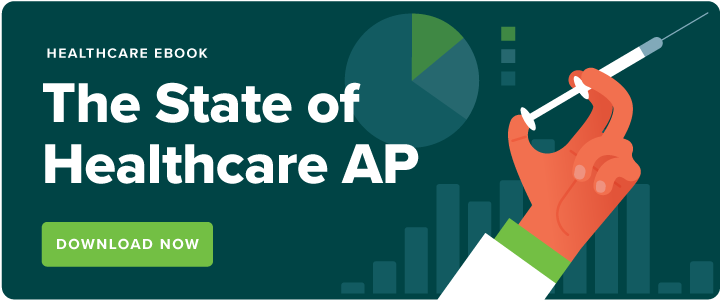A typical healthcare organization’s accounts payable process is highly vulnerable to disruption. Rapid changes in projected volume and cash flow can prove challenging (both operationally and financially) for providers. Optimizing cash flow is essential to securing financial health and overall business sustainability.

The coronavirus pandemic and recent inflation issues have particularly impacted healthcare companies. These conditions have forced many of these organizations to pause clinical trials for drugs unrelated to COVID, resulting in less innovation across core product lines. Additionally, inflation and supply chain issues have forced organizations to prioritize their business operations and the associated costs.
In this article, we will explore the importance of maintaining healthy cash flows within the healthcare industry and how providers can maximize their earnings.
Defining Healthcare Cash In-Flows and Out-Flows
Cash in-flows and out-flows often dictate financial success in any sector. Monitoring and understanding cash flow within your healthcare organization will help optimize revenue and drive awareness to areas that warrant improvement.
Cash In-Flows
Cash in-flow is revenue generated directly to the company. These can range from patient payments (e.g. a patient paying their dentist bill) to insurance reimbursements.
Cash Out-Flows
Cash out-flow is the opposite of in-flow, where money leaves the business as a result of operational costs such as payroll, rent, taxes, supplier payments, and other company expenses.
Healthcare providers must be cognizant that their cash out-flows never exceed their cash in-flows. Essentially, organizations shouldn’t spend more than they receive, otherwise they risk hindering organizational growth, liquidity, and their competitive edge within the industry.
Why is Cash Management Important in Healthcare?
In a recent report, Forrester found that nearly 74% financial leaders agreed that COVID highlighted the need for more accurate cash forecasting. Managing cash flow effectively enables executive teams to better understand their company’s financial standing. Effective cash management can reduce risk for companies, increase stock price, and allow the company to reinvest money into the business.
The objective of cash management is not only to ensure healthcare providers have sufficient funds to improve resources, pay staff and suppliers, and remain competitive within the industry, but also to ensure that the collection and disbursement of payments for services and purchased goods happens efficiently.
Without positive cash in-flows and a steadily managed out-flow, organizations may not have an accurate understanding of available funds. This can lead to overspending, strained supplier relationships, misrepresentation of available funds, over-hiring, and even closure. Therefore, proper cash management guarantees a company the financial stability necessary to continue their business.
Pressure Points on Healthcare Cash Flow
Over the last year, many patients were forced to prioritize immediate payments such as rent or a mortgage before paying their outstanding medical bills. This created a large financial strain for many healthcare providers and hospitals. For other sectors in the industry, such as pharma and biotechnology, supply chain delays caused lost profits and missed opportunities.
As we turn a new corner in the pandemic, it is important to understand the typical cash flow pressure points for healthcare organizations:
1. Paused Clinical Trials
The pandemic forced companies to prioritize COVID over other drug development initiatives. However, these delays in research can have a big effect on the bottom-line, especially if patents on existing products are running out. Companies must instead look for other ways to increase their revenue.
2. Finding the Right Talent
Most industries have been affected by the Great Resignation. However, due to burnout caused by the pandemic, healthcare organizations, such as hospitals, outpatient services, treatment centers, and more have been especially hindered. As many healthcare orgs scramble to fill open roles across all departments, many must deprioritize back office hires to focus on filling life-saving roles like doctors and researchers.
Even when healthcare organizations begin to backfill some of the business operation roles, such as AP, finding the right people can be a big problem. 50% of accounts payable departments surveyed anticipate delays or challenges in finding the right people to fill open roles on their team.
3. Manual, Labor-Intensive Tasks
Healthcare companies face a number of challenges to optimize their AP. For example, 31% of healthcare organizations cite that enrolling and managing suppliers is an AP automation obstacle, while 20% note that payment authorization remains a pain point for their team. 38% of teams spend 6 or more hours a week answering supplier questions, which are generally related to tracking invoice payment status. Additionally, manual processes are prone to human error, which can be costly in terms of vendor relationships or company audits.
Automation directly addresses these challenges, freeing up teams to address more strategic tasks for the organization.
4. Lack of Digital Payments
About 33% of all companies make more than 50% of all invoice payments via check, although it’s a more expensive means of payment. In healthcare, this number is even higher, with 42% of companies using checks to pay over half of their payments.
Between their hard and soft costs, checks cost organizations about $5 per invoice. By switching to electronic payment methods, companies can save $5,000 after paying just 1,000 invoices.
4 Steps to Manage Cash Flow in Healthcare
Below are four steps that companies can take to better manage their cash flow.
1. Reduce Day-to-Day Operations Through Automation
Manual AP processes are an expensive line item for healthcare companies. Manual AP provides less flexibility, making it difficult to recruit talent in a competitive marketplace. These processes also make it difficult to scale the business or operate in a hybrid work environment.
A manual AP workflow can also strain supplier relationships, which have become more strategic for most organizations over the last year. Manual AP processes’ can take up to 3x longer to issue invoice payments, cost more to maintain, and are less secure than automated solutions. In order for healthcare organizations to improve their cash flows, they must begin to optimize their accounts payable processes.
AP automation solutions streamline and automate invoice processing, from capture to payment. This allows healthcare organizations to easily schedule payments and authorize invoice approvals, on time, everytime. A simple click of a button can result in fewer missed payments, ensure accurate payment processing, and allow providers to quickly match, approve, and pay invoices from suppliers.
AP automation speeds up invoice processes and helps to avoid late-fees and free up capital from previously manual tasks. Healthcare businesses gain the ability to easily schedule when payments are sent out, control when cash leaves the company, and gain visibility into invoice real-time statuses. Say goodbye to printing and signing checks–AP automation solutions can enroll companies in virtual card payments for you, without adding additional workflows to your AP process. Then you can focus on what’s most important, providing unparalleled care for patients.
2. Accurately Capture Data
In order to properly manage cash flow, it’s important to have an accurate overview of the company’s financial standing. However, it can be difficult to get a real-time snapshot of the financial health of your business without automation in place. Additionally, teams that employ manual processes risk subjecting their invoice information to human error.
By using an AP automation solution like MineralTree, your team can accurately capture invoice information. Thanks to OCR technology and human review, MineralTree captures data with 99.5% accuracy. The system also captures line item information, which can be fed into financial reports for a more accurate forecast. Additionally, invoice data can be leveraged in reports and AP forecasts as soon as the invoice is captured. Finance teams no longer have to wait for an invoice to be posted to the ERP system to use the data in their analysis.
3. Use Analytics to Maximize Cash Flow
AP analytics and reporting is a valuable tool to improve cash flow. By leveraging a reporting tool alongside your automation platform, you can gain insight into the following:
- Rebates earned
- Fraud risk
- Number of duplicate payments
- Current payment mix
Consider leveraging the following reports to improve your company’s cash flow management.
Days Payable Outstanding
There is no such thing as a good or bad DPO. A lower DPO can improve supplier relationships, while a higher DPO can result in more cash on hand to reinvest into the business. In 2021, Macy’s extended its DPO payments from 134 to 163 days. In June of that year, Macy’s had improved the cash on its balance sheet by 18% when comparing quarter over quarter numbers ($1.8 billion dollars).
Many companies, who take a strategic look at their DPO, opt to do a mix, based on how vital a vendor is to a business. Lowering the DPO for strategic partners can assist in relationship management, which is critical during supply chain issues. However, for less vital suppliers, having a higher DPO can prove beneficial since your company will have more cash at its disposal for longer.
History of Payments
There is a common misconception that suppliers do not want to accept digital payments. According to 50% of healthcare organizations, a vendor’s willingness to accept virtual payments is the biggest obstacle to enrolling more suppliers in more electronic payment methods. However, 82% of vendors noted that they do want to receive more digital payments.
It’s no secret that checks are more expensive than virtual payment methods. They can also open your company up to security risks, and are easily lost or misplaced. Although there are countless benefits to switching to digital payment means, it can be difficult to prioritize the order in which to enroll vendors in electronic payments. Analyzing the current payment mix is critical to this process.. Additionally, MineralTree can cross-reference your list of vendors with our database to determine who already accepts digital payments. For those that don’t already accept electronic payments, MineralTree can help enroll them, freeing up time for your AP team.
By leveraging the History of Payments report, you can determine how to optimize your payment mix. Specific kinds of digital payments such as virtual cards, can provide an additional revenue stream for your company through rebates. Forge Biologics, a company that develops life-saving gene therapies, is on pace to earn $80,000 in rebates this year due to enrolling vendors in virtual cards.
Discounts Captured
Many vendors offer early payment discounts. By taking advantage of these discounts, your company can save money on the invoices paid, while improving relationships with suppliers.
4. Conduct Financial Audits at Regular Intervals
Financial audits can lower the risk of invoice fraud or mismanagement of cash. By conducting audits at regular intervals, your team can mitigate errors and ensure that financial records are accurate. By using an AP automation tool, this process can become less manual, allowing your team to reduce errors, while addressing any mistakes that do occur quickly.
How AP Automation Maximizes Cash Flow for Healthcare Facilities
We all know that time is money. By switching to an accounts payable automation system, healthcare facilities will gain valuable time, and, as a result, solve challenges across the organization, including cash flow, supply chain issues and the increased demand for healthcare-related services due to the pandemic. With faster and easier payment methods, an organized collection process, and a decreased need for manual labor, providers can expect to improve the amount of invoices paid on time (up to 9%) and save nearly $3 on cost per invoice.
This was definitely the case for BrightView Health. BrightView Health had experienced substantial growth, expanding from four to thirty centers in only two years. Although expansion met their corporate goals, they experienced several growing pains that stemmed directly from their accounts payable processes and financial organization. After moving their company’s ERP system to the cloud, they began improving their AP process. Having previously operated AP manually, BrightView relied on one employee to enter invoice information, convert invoices to PDFs, and then update spreadsheets with exuberant amounts of data. AP automation was the necessary next step in order to keep up with the scale of the quickly growing business. Once BrightView Health made the switch to MineralTree, the company’s productivity skyrocketed: They were able to process 150 invoices per day, organize invoice data in one place, and prepare audits in a fraction of the time.
For BrightView Health and many other companies, switching to AP automation is the key to maximizing efficiency, cash flow, and freeing up capital to invest in further operations and services. At MineralTree, we provide our clients with a guarantee of 99.5% accuracy on every invoice captured and serve as the catalyst to exponential growth within your company.



